Fueling your Car
What Is and Isn’t Inside an EV?
What is an EV? What are the obvious things that set an EV apart from the more conventional car that’s powered by an internal combustion engine (ICE)? And what is an EV like to maintain?
These are just a few of the good questions that might be rattling around in your mind as you consider the possibility of EV ownership. Let’s face it, most of us probably jump inside our cars and give little thought to what happens inside a car when we drive off.
Let’s start by answering the first question and develop for ourselves an understanding of what an EV is.
The letters ‘EV’ stands for the words ‘electric vehicle’. EVs don’t have a combustion engine underneath the bonnet, in fact they don’t have a combustion engine at all. This means that you won’t need to pull over at the gas station to fill your car up with any form of fossil fuel (e.g., unleaded gasoline (91), premium unleaded gasoline (95, 98 or 100 octane) or diesel. Neither will your car be running on gas (LPG or CNG). You won’t even have to top your car up with engine coolant or oil for engine lubrication. Sounds good!
Once you look away from the various processes of mining earth metals like lithium and cobalt (a by-product of nickel and copper mines); neodymium, terbium, or dysprosium (critical metals used in higher powered batteries that can last for longer distances – and everyone wants to be able to last longer) used in EV batteries and electronic componentry, EVs look to be more environmentally friendly and interesting cars to own and drive.
All your power is electronically accessible to your accelerator pedal, and your braking action is processed electronically as well. When you brake or decelerate, battery power can be reverted back into the battery pack. Basically, drain the battery in an EV, and you’ll need to plug it into a charging port again before you can get some power for driving about again. However, that’s nothing new now, is it?
To get power from your house power supply, you’ll need to have a conversion kit built into your home’s power system in order to be able to power up your EV within a suitable time frame, commonly 6 to 10 hours. More expensive options are available that will enable a quicker charging time. To get power after commuting around the city, you’re going to require a charging station or a park at work that has a convenient and vacant plug-in port for you to charge your vehicle up again to get home. There are some other charging stations (and we’ll need many more of these with more EVs running on the road) where you can park up for a couple of hours to recharge or top-up again for your commute home. If you drive your EV out of town and into the country, you’ll need to be sure that you have enough power between charging ports, because, unlike in a vehicle with a combustion engine, a jerry can won’t get you out of trouble nor will the longest power cord. I’m not sure what serious Outback off-roading enthusiasts will do if they drive an EV. Neither am I sure what mobile ‘tradies’ will do when they get caught short on power between towns.
What is missing inside an EV that you have in a common ICE vehicle?
Noise is the first thing that comes to mind. EVs do without the mechanical noise of the combustion/explosions that takes place inside a working ICE. What you do get is a very quiet ride with a bit of road noise from the tyres and wind about the bodywork as it slips through the air. Exhaust emissions are also a non-event.
EVs have no complex clutch or gearing, which means that EVs can accelerate smoothly and quickly, giving you the feeling that you’re driving a sports car. Instant maximum torque is always accessible.
A purely electric EV has fewer moving parts. There are only around about 20 moving parts in an electric motor, compared with nearly 2000 mechanical components in an ICE. The result is that an EV will need less fiddly routine maintenance jobs like changing the engine oil every 10,000km. You’ll still need to change the tyres on an EV, and you may go through more tyres because of all that instant torque and acceleration. A pricier tyre made up of a softer compound might also be necessary in order for you to be able to stick to the road better with the EV’s instant and quick acceleration.
You will also need to replace the battery pack, as they do have a life. This will be the one expensive maintenance bill. Buy a new EV, and you’ll be able to put this off for 10 years or so. Buy a second-hand EV, and who knows how long you’ll have before the battery pack will need replacing or you just won’t be going anywhere.
An EV owner will likely also need to pay some sort of road user charge or tax in the not-too-distant future, particularly if more EVs take to our roads.
However, own an EV and you won’t need an ICE tune-up or oil change, and the engine coolant won’t need to be replaced, either. In essence, an EV has no petrol, diesel or oil. It has no exhaust, no clutch or gears. It doesn’t have spark plugs, and it has no throbbing combustion noise that you find you get with a V8, a boxer or even a straight six.
As with any car, EVs have both their advantages and their disadvantages. At this stage, an affordable EV would be a great and enjoyable car for the city environment.
EV Revolution

Let’s ditch fossil fuels and crude oil for a while, since some say that oil is considered environmentally unclean and unfit for burning. So, what about electric? Which of our earth’s finite resources are needed to make electric vehicles (EVs)? It will be Tanzania, Venezuela, the Democratic Republic of Congo, Canada or even Brazil who could be the providing the rest of the world with precious raw metals that the greener EV requires.
As electric cars appear to be going mainstream and all our main automotive manufactures look to ditch internal combustion engines (ICEs) by 2025-ish, these big automotive giants have to source and make investments into electric cars and their necessary componentry. Countries like South Africa, Tanzania, China and even Australia have very mineral-rich and rare metal resources. These countries and their mining industries are the world’s best environmentally friendly strategy to power EVs and their mass production.
There is a global race on that is driving the demand for countries, including quite a few in Africa, to mine as much of their precious metal resources to equip the world with a greener fleet of vehicles. This clambering for sourcing all the right stuff for EV production en masse could soon provide billions of dollars into certain countries’ GDP rates.
Rare metals like copper, lithium, cobalt and nickel are some of the most discussed metals in EV production demands. Other metals like neodymium (a rare earth metal), aluminium and zinc have emerged as some other new resources that will be needed in the rapid quest for a greener world. Statista, a German company specializing in market and consumer data, estimates that the demand for metals such as nickel, aluminium, and iron (all the critical components in EVs) will jump to as much as 14 times the rate that it is now by 2030. This huge demand for environmentally friendly EV minerals for meeting the green EV car revolution will provide a great cash injection for a well-endowed African state. Demand for metals like lithium and graphite are also expected to rise substantially, even by as much as 9-10 times by 2030.
The large estimated increase (14x) in demand for the clean EV minerals to meet the intended global EV production rates over the next ten years is accompanied by the need for vehicle battery outputs and infrastructure, which are expected to rise by millions of times over in the very near future. Even Toyota recently announced a 13.6 billion US investment into electric cars and hybrids, with some 9 billion US dollars to be spent on battery production alone. This is fantastic news for the environment and carbon zero.
The increase in demand for these rare and hard to obtain metals is pushing top mining and big investment companies around the globe to invest in the acquisition of key materials used in the production of EV batteries, EVs themselves, and their much needed electrical infrastructure. Solar energy componentry, as well as the EV requirements, all point towards an enormous boom in demand for these rare and hard to reach resources, as well as creating an opportunity to make even more money than the awful and “dirty” fossil fuel endeavours.
It is expected that the sales and production of EVs will continue to accelerate quickly over the next five years. Big automotive giants who are changing to larger-scale EV production have major mining countries like South Africa, Namibia, the Democratic Republic of Congo (DRC), Tanzania, Zimbabwe and Botswana on their radar. These are just some of the main African countries, let alone other countries around the world, who enjoy bountiful reserves of some of the world’s most precious metals and minerals: minerals such as gold, diamond, cobalt, iron ore, coal, and copper. Meeting the demands by governing authorities and their growing appetite for better and greener EVs will be much better for the environment – and for special places like Africa, I’m sure.
President Hakainde Hichilema is the new president for Zambia, and he has recently announced plans to ramp up mining in particular, and to jump-start Zambia’s economy. Part of his economic plan provides for the rapidly growing EV battery industry, with cobalt and copper identified as key components. The workforce will be a great place for young men from the age of 15 years old, who will be able to work in the dangerous mining industry. Countries like Zambia and Tanzania are working hard to supply the developed countries of the world with the rare metals. The developed countries are considered to have a higher status and economic standing, a better understanding of the environment, human ethics, health and emission standards. Their demand for a green EV world is a good thing for all people and the environment.
As the big green machine, Tesla, and auto giant Toyota are joined by other larger EV-producing manufacturers, African mining countries are going to have to move faster than ever to meet the demand put on them by the governing authorities of the world and their ever-increasing and severe carbon emission goals and standards. The president of Zambia, Mr. Hichilema, has wasted no time in announcing his administration’s hopes to quickly provide the clean EV battery supply chain and invest much of his country’s proceeds into its development.
Rare metals and their difficult and extensive underground extraction methods are needed in EV lithium ion battery technology and are critical for improving the driving range of electric vehicles so that they can compete with the best, most frugal, “archaic” ICE technology and emission-capturing methods. These rare metals are buried beneath the fields of African nations, ready to be harvested by economically sound, rich and developed countries with zero carbon emission goals and standards.
South Africa, a mining giant, has also announced plans to set up production plants to manufacture EVs of their own, including plants for the manufacture of EV components, such as EV batteries. This could see South Africa as one of the multi-billion-dollar raw material producers of the world. South Africa already has its raw material extraction industry, its capital markets, and its existing manufacturing and export infrastructure to build upon.
Environmentally friendly keywords that current governments, economists and greenies around the world are sharing with the public are words like carbon emissions, climate change, EVs, EV infrastructure, mining, metals, zero carbon, clean technology, investment and climate crisis. All of these keywords correspond with the rising demand for the precious metals used in EV production.
As it stood in 2020, the total global nickel reserves amounted to approximately 94 million metric tons. Of that amount, it was Indonesia that held the world’s largest share. Following the tropical and beautiful Indonesia is Australia, with our nickel reserves estimated to be 20 million metric tons. Best we get stuck in, then!
BMW Brilliance

BMW has always been a favourite standout brand of mine, and BMW is forging new models and technology even as we speak. It has been a bit of a gruelling year-or-two with the covid shenanigans, and car manufactures are only one small segment of the global economic pie to have taken a sizable hit. The shortage of semiconductors has been, and still is, a problem because cars rely on these items for controlling anything from your electric windows to all the fancy driving assistance aids. However, the winds are changing, and the rebound is occurring. Luxury car marques like BMW seem to be doing very well, and even with the electronic chip shortages being a bit of an issue it seems that BMW will get through this period in fairly good shape. There is always a talking point re this special car marque; sometimes the designs might look great to some and not so flash for others, but there is always a gem being turned out from this great team of motoring designers and manufacturers. BMW cars are more often than not great to drive, good looking, practical and advanced cars.
In this covid recovery period, various chief financial officers recently mentioned that, for now, luxury marques like BMW would consciously undersupply demand levels, which seems a prudent, sensible path to take, as BMW new car prices are holding up very well – quite bullish in fact. The increased pricing power has already trickled down to the bottom lines for BMW and Daimler. Mercedes achieved a 12.2% return on sales in the last reported quarter, which was up from 8.4% in the same period in 2018 (2018 being of a period not affected by the pandemic or diesel emissions litigation costs). BMW achieved a 16% return on sales, which was up from 8.6% in 2018. BMW also reported a $5.7 billion net profit in the second quarter of this year, suggesting global auto markets are continuing to recover from the pandemic — particularly when it comes to luxury cars like BMW and Mercedes.
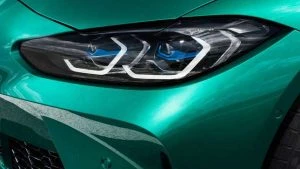
BMW M4 Minty Green
This is great news for BMW and car lovers in general, but what’s new in BMW’s box of tricks? A very cool thing that BMW revealed at the recent Munich Motorshow (early September 2021) was to be found in the BMW M4 corner, where this manic machine, with its impetuous acceleration, showed a jaw-dropping minty green sheen to its beautiful, sexy exterior. The M4 Competition wore a Mint Green paint job and sat upon gorgeous bronze 20-inch rims. Both of these options are available as part of the brand’s expanded BMW Individual customization line, which you can find on BMW’s online configurator, where more than 130 other paint options and eight different wheel options are available. This latest BMW M4 Competition also had a new fibre front splitter, a restyled rear bumper, a rear wing, and some unique side skirts that were all made with carbon fibre. Carbon fibre interior seating surfaces and trim pieces are also part of the online configurator. So, try before you buy!
The Munich motor show also allowed the public to preview a hydrogen-electric BMW X5 that is due to enter very-limited production in 2022. This is an exciting moment because the vehicle was first previewed in 2019 as the i Hydrogen Next concept. It’s currently in the prototype stage, and early this month it was confirmed with the go ahead, going by the name of BMW iX5 Hydrogen.

A hydrogen-electric vehicle is like a battery-electric vehicle, but instead of drawing power from electricity out of the charged battery the hydrogen-electric vehicle relies on a hydrogen fuel-cell stack to produce electricity power. BMW’s iX5 Hydrogen has the hydrogen fuel-cell positioned up front where it draws hydrogen from 2 tanks, one in the X5’s transmission tunnel and another under the rear seats. The tanks are made from carbon-fibre-reinforced-plastic and can hold about 5.9 kg of hydrogen at more than 10,000 psi. Tank filling takes only a few minutes. The hydrogen fuel-cell combines hydrogen with oxygen from the air to create electricity. This process only has water (H2O) as a by-product – Wow! The electricity primarily powers a single motor at the rear axle but is also used to charge a small battery that steps in from time-to-time to deliver extra grunt to the motor during high-load situations.

BMW iX5 Hydrogen Platform
The BMW iX5 Hydrogen will have a total system power output of 275 kW. The hydrogen fuel cell, on its own, generates about 125 kW. The vehicle’s aerodynamically shaped 22-inch wheels are wrapped in a new Pirelli tyre that is made from natural rubber and a wood-based synthetic fibre known as rayon. These two materials replace much of the petroleum-based synthetic rubbers used in modern tyres.
The extensive field testing has already started in earnest within Europe. Particular focus points have had the engineers examining how effectively the CO2-free drivetrain works in real-life conditions. Also, they are measuring metrics which include reliability, safety, and efficiency during everyday conditions to ensure that the new model is perfect for mass production. Hydrogen fuel cell technology has the potential to supplement internal combustion engines, plug-in hybrid systems, and battery-electric vehicles. The BMW iX5 Hydrogen has hydrogen tanks that can be filled quickly in only 3–4 minutes.
BMW states that the small batch of iX5 Hydrogen models that are destined to be built in 2022 will only be used for demonstration and testing purposes. BMW doesn’t expect to have any hydrogen-electric vehicles at dealerships until 2025 at the earliest and depending on the direction that the automotive markets take.
Newest off the showroom floor is the all-new BMW iX3 with its refreshed exterior design. The new BMW iX3 has a sexier appearance and introduces the M Sport Package as standard. BMW has achieved an impressive CO2 emission assessment for this next-generation iX3, and the vehicle boasts an exceptionally efficient drive system. Extensive use of secondary raw materials in the manufacture of aluminium castings and thermoplastics combines with the new iX3 boasting an absence of rare earth materials and the use of more green electricity in its production.
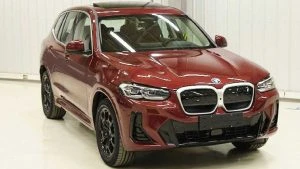
BMW iX3 2022
The BMW iX3 has a kidney grille that is larger still, and it has a single-piece frame that comes in Pearl-effect Chrome with blue accents to match with the BMW i styling cues. Its headlights have been made slimmer. It also boasts 19-inch black aerodynamic wheels, an automatic tailgate, adaptive suspension, a heated steering wheel, a panoramic sunroof, and Smartphone integration with Apple CarPlay and Android Auto.
BMW is a bit of a landmark in the automotive world, a benchmark, the perfect blend of performance, luxury and practicality. In the future, BMW wants to be ready to supply customers with their powertrain of choice, whether it be gasoline, diesel, battery or hydrogen. In the case of hydrogen, BMW sees it as an opportunity for customers that favour long-distance driving or who happen to live in regions without adequate battery recharging infrastructure.
I have so many favourite BMWs and other cars, including the 4.0-litre Falcons, which have rolled our roads over the last few decades of motoring, but let’s not be nincompoops and let’s embrace new ways of automotive power; let’s embrace the new BMW i technology.
New EV SUVs
We still seem to be desiring the SUV over other shapes and styles of car. This is for reasons that I can understand; things like safety, space and ride comfort tend to be found in spades when you travel inside a decent-size SUV. Because we are likely to go through a period of history where the EV may well rule the road, are there any SUV-type EVs available now? EVs aren’t selling like hot cakes just yet, but there some EV SUVs bigger than a pint-sized Honda E that you might be interested in. It turns out that, actually, there are some pretty decent EV SUVs available to the buyer loaded with cash. As yet, they aren’t the cheapest vehicles on the planet, particularly if they are of the premium luxury brands, but it’s nice to know that if you did have the money, and wanted a spacious and desirable luxury model, they are already being sold out on the market.
Tesla has the jump on its competition, and they already have a decent wodge of EV clients under their wings. Because it was pretty much the first EV manufacturer to design and build a decent EV, it was Tesla who soaked up the early adopters of Tesla’s EV technology, and it was these buyers who were very keen to align and embrace the new EV technology early on. What is happening now, is that because other manufacturers are only now getting fully into the swing of EV technology, the keenest buyers have already been wooed and taken by Tesla, so, for instance, if you are an Audi e-tron or Jaguar I-Pace, you have a slightly harder job of getting your buyers because you have to actually entice them away from their luxury ICE vehicles and into one of their EV variants.
Tesla Model X
Let’s first give credit where credit is due, and let’s talk about the Tesla Model X EV SUV. The Model X can come with an optional six seats, the middle row boasting full-on Captain’s chairs. The five-seat Model X is the standard guise. I love the falcon-wing doors; they look so cool and make life very easy getting in and out of the car – even in tight parking spaces with as little as 11-inches on either side. Tesla’s Model X cabin is nice, big, and comfortable. Up the front, there is a big infotainment display screen on the dash. This is as big and as good as it gets in any car. The roof/ceiling is also a huge display screen, which is tinted so that the glare from the sun is minimised. The Tesla feels extremely modern but also, at the same time, quite a simple car that is fun to live with. It has funny features like a Fart Mode, which is an emissions testing mode that allows the car to perform fart sequencing and farting whenever it requires to do so. People outside don’t escape the sounds either. This feature does leave one in hysterics – you have been warned! The Tesla Model X is very different to anything else on the road, and that makes it a unique drive. Out on the road, the Tesla Model X is quick, and its ride does a pretty good job of soaking up the bumps. There are better handling cars like the Audi e-tron and Jaguar I-Pace, however.
- Twin electric motors
- 100kWh battery
- Weight: 2459 kg
- Range: Claimed at over 500 km, real world driving more likely to be around 300 km.
- 310 kW of power
- 660 Nm of torque
- Top speed: 250 km/h
- 0-100 km/h: 4.9 seconds
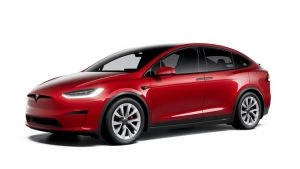
Tesla Model X
Audi e-tron
Audi’s new e-tron has five seats, all rather comfortable and impeccably crafted. The touchscreen system is classy, right up-to-date, and detailed. You do have plenty of menus to work through before finally getting to where you want to be in the infotainment set-up. On the road, the Audi e-tron is exceptionally well-sorted. It feels really tight around the corners, smooth and very quiet. Though EVs are generally heavy vehicles, the e-tron disguises its mass very well, indeed. There is plenty of well thought-out storage compartments throughout the cabin, and on a day-to-day basis this is a nice EV SUV to live with.
- Twin electric motors
- 95kWh battery
- Weight: 2490 kg
- Range: Claimed at around 385 km, real world driving more likely to be around 300 km.
- 300 kW of power
- 664 Nm of torque
- Top speed: 200 km/h
- 0-100 km/h: 5.7 seconds

Audi e-tron
Volvo XC40
Volvo’s XC40 Pure Electric Hybrid is a smaller luxury EV SUV. Safety features include autonomous emergency braking, run-off-road assist and up to Level 2 self-driving in heavy traffic situations. It’s available with AWD and uses a nice silent, smooth electric set-up. The Volvo’s version of an EV SUV is a gem. The XC40 looks and feels very modern, and the XC40’s cabin is impressively spacious. Standard equipment levels are high and include a 12.3-inch digital instrument panel with configurable EV-specific displays, panoramic sunroof, heated front power seats, and inductive charging for your smartphone. Also standard, is the full suite of Volvo safety features, including lane keep assist, blind-spot and cross-traffic alert, and rear collision alert. The 460 litres of boot space opens up to 1336 litres with the rear seats folded down flat. These can be bought new for around $85k, making this a well-priced premium luxury EV SUV that is comfortable and swift.
- Twin electric motors
- 78kWh battery
- Weight: 2158 kg
- Range: Claimed at around 418 km, real world driving more likely to be around 300/350 km.
- 300 kW of power
- 659 Nm of torque
- Top speed: 180 km/h
- 0-100 km/h: 4.7 seconds
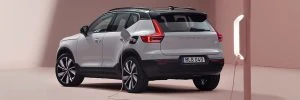
Volvo XC40 Recharge Electric
Jaguar I-Pace
In my opinion, the Jaguar I-Pace wins the EV SUV beauty contest. From every angle it looks nice, athletic, and the perfect blend of old and new design. Even with its GT lines there is a nice amount of space inside the EV Jag. To drive, the Jaguar I-Pace is wonderful. It feels very crisp through the corners and it even has a satisfying growl that flows through the speaker system as you plant your right foot and accelerate hard. Compared with its rivals, the new Jaguar I-Pace weighs in at a comparatively light 2.0 tonnes. This is a lovely EV SUV and is probably the one I’d prefer most of all the snobbish EV SUVs currently on sale.
- Twin electric motors
- 90kWh battery
- Weight: 2068 kg
- Range: Claimed at around 420 km, real world driving more likely to be around 300 km.
- 294 kW of power
- 695 Nm of torque
- Top speed: 200 km/h
- 0-100 km/h: 4.5 seconds
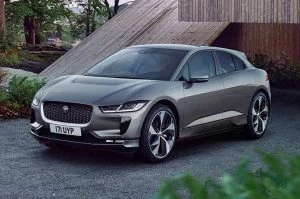
Jaguar I-Pace
BMW’s latest iX and Mercedes Benz’s EQC are some other luxury EV SUVs worth a look at. And then some other considerations that are substantially cheaper than the premium EV SUVs mentioned above would be the small Mercedes-Benz EQA and the very good MG ZS EV, Hyundai Kona and Kia Niro.
Some big reasons why you’d want to change to a EV SUV right now would be the driving smoothness, the driving silence, self-driving safety features, and the potential for saving money at the “pump”. I think it was Top Gear who recently suggested that, on average, the running costs of one of these were on a par with an equivalent petrol car capable of 73 mpg (3.2 litres/100 km). That’s if you were to do most of your charging at home and not at public charging stations.